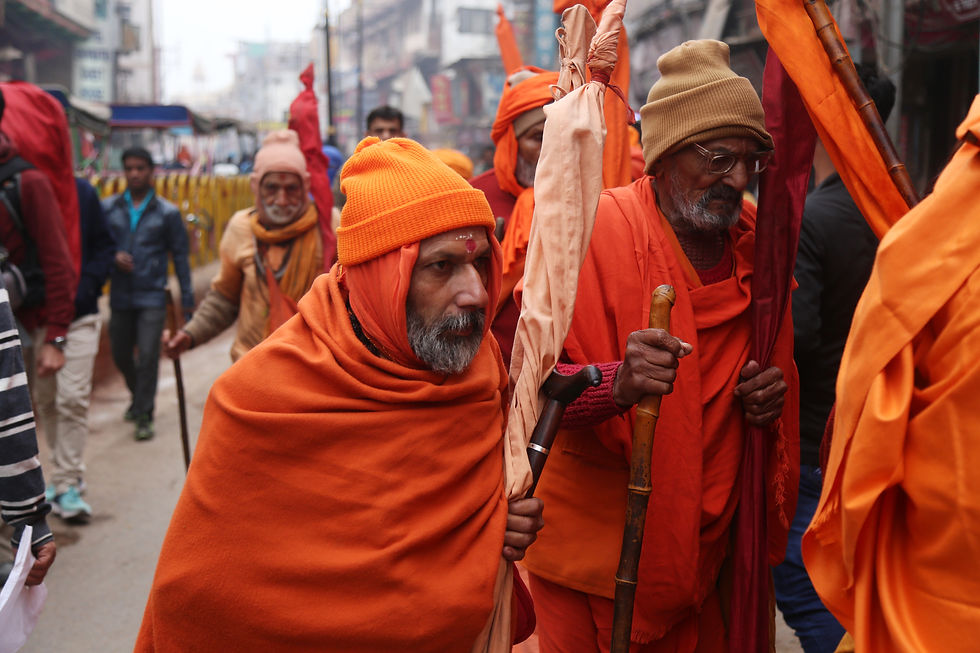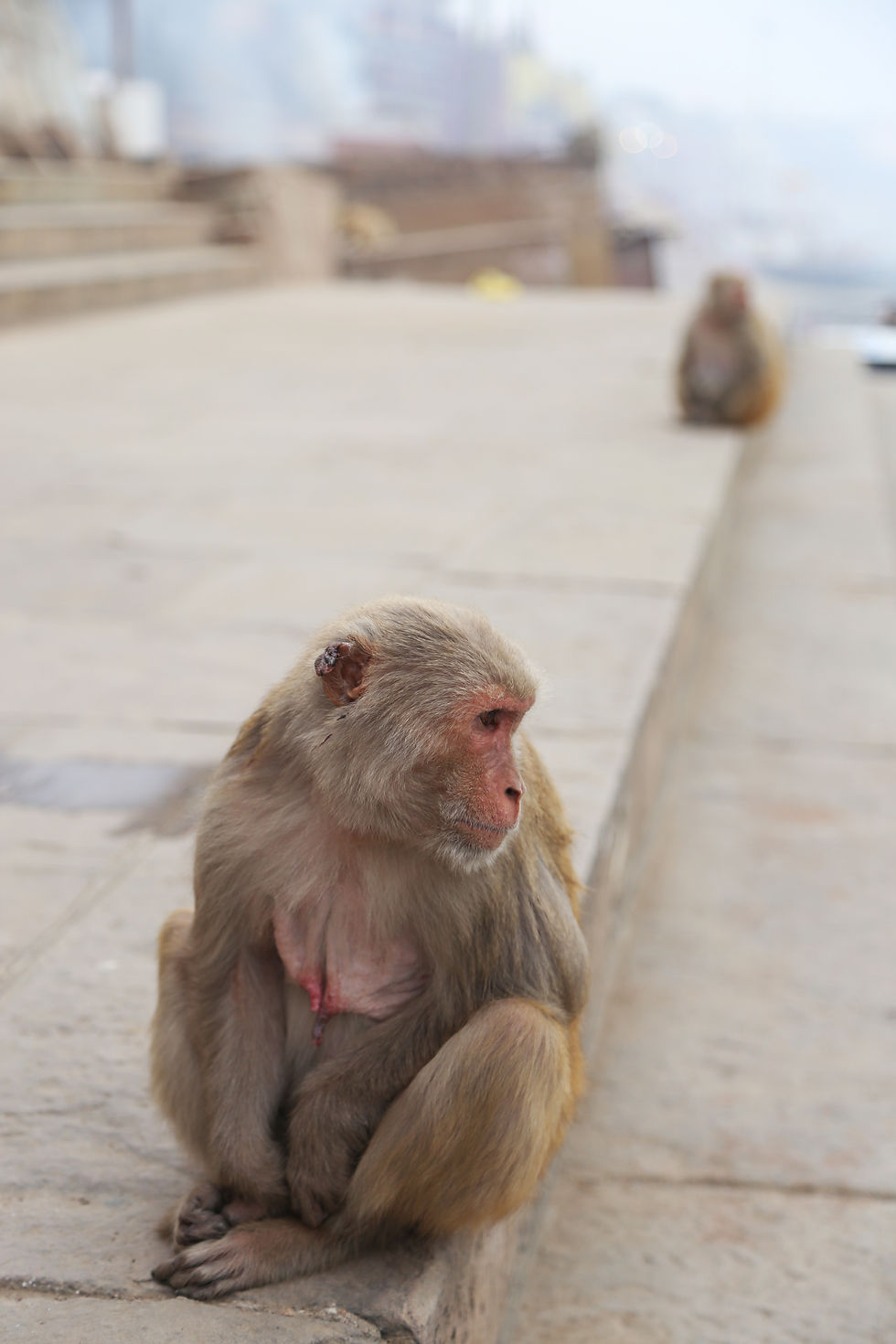On Ritual and Jewish Bodies

Last week, one of my students asked me if Jews believe in multiple gods. Growing up, monotheism was one of those primary aspects of Judaism which was preached through every holiday and Hebrew lesson. It caught me off guard that this child wouldn't know the answer, and further, that without knowing the answer that they would even think to ask the question. I thought of the story of Abraham at the age of three discovering monotheism on his own, and going on to spread it to the masses. But then I realized that here in India these Jewish children are surrounded by polytheistic religions everyday. That every time they walk down the road or go into a shop or turn on the TV they see miniature idols and altars and rituals that are not their own. I answered that Jews do believe in one G-d, and I, along with the group of 5-13 year olds sitting cross-legged on the floor of the JCC, picked through what specifically defines a religion as monotheistic.

In December my parents came to visit me here in India. They stayed with me for a week in Mumbai, coming around with me to all of the different projects and classes that I work with. They then toured around Rajasthan on their own (with a driver) for 10 days, and stopped in at the Taj Mahal before I met them in Delhi. We spent a week in Delhi and Varanasi before heading back to Mumbai for a few more days, and then they went home. Delhi was really my first experience getting out of Mumbai, and my first encounter with an India outside of this Maharashtrian peninsula which is slowly becoming my home. While Delhi was beautiful and vibrant and hectic and wholly different from Mumbai, Varanasi was something else completely.

Varanasi is located 1535 kilometres Northeast of Mumbai in a state called Uttar Pradesh. Referred to as Benares by the British, Varanasi lies on the North-Western shore of the Ganges River, not far from where it splits off into the Yamuna River. The city has been occupied by various religious sects and political dynasties continuously since before 1200 BCE, and is considered to be one of the holiest cities in the world. Sounds familiar, no?

One of the reasons why Varanasi is such a holy city is that Hindus believe that someone who dies in Varanasi and has their body cremated and scattered in the Ganges River will achieve moksha, or the emancipation from the cycle of reincarnation. As such, many people come there to die. Cremation ceremonies, river-based prayer rituals, and hundreds of stray cows roaming the cobblestoned lanes made for a city unlike any I've ever experienced.

The whole edge of the city which lies along the river is lined with ghats, or wide concrete stairwells, which lead down to the river. The Manikarnika Ghat is the main cremation ghat. As you approach it you walk past endless piles of wooden logs for sale. The stench of bitter smoke wafts through chai stalls and lone altars pressed with marigold-coloured pigment. I walked to the edge of one of the log-piles to get a better view, and below me stretched an expanse of human ashes and the bamboo poles of discarded stretchers used to bring the bodies down the twisting stone alleyways.

This is not the first time I've been exposed to large amounts of human ashes. In the summer of 2015 I visited Poland for the first time. On June 30 I visited the Majdanek concentration camp on the outskirts of Lublin. The ashes of the Jews who were burned in the crematoriums of Majdanek are today housed under a concrete monolithic dome rising from the expansive fields of Polish countryside. I stood under the concrete dome while the Rabbi of our group wrapped himself in his Tallis and said Kaddish - a ritual meant for reflection and rejuvination. The wind picked up particles of human ashes and blew them into our noses.

January 4, 2018. I woke up early and took a stroll along the riverfront. As I passed Manikarnika ghat, a very different type of human ash blew into my nose. As a Jew, I feel like the act of cremation comes with certain connotations. Especially as someone who has spent so much time visiting death camps in Poland, I find it difficult to escape those associations. Yet the bodies burning on wooden pyres in Varanasi are worlds apart from the Jewish bodies of Poland. As I see families gathered to say goodbye to their loved ones, eldest sons adorned in white sheaths sprinkling layers of ghee and incense over the bodies of their fathers, I think of the Jews for whom cremation was the ultimate act of destruction. How can these two ends of the same action be reconciled? How can these two religions share this action in history, yet be so many worlds apart from each other in their intention? I think of the sonderkommando, the special units of Jews who were enslaved into working the crematoriums of the death camps, almost always before being murdered themselves. Yet there is no comparison. For the sonderkommando cremation was the ultimate act of torture and defilement, but for these families, the ritual serves as a celebration and emancipation of the soul.

So here we have two religions, both with very intimate connections to the act of ritual practice. Yet how can one ritualized action mean one thing to one religion, and one so totally different to another? How can a Jewish girl sit and watch active cremations so soon After Auschwitz and not view it through the lens of trauma? Should she? Is it fair to? Can we find beauty within the ritual of another, when the ritual evokes the communal trauma of so many? I think of the emotional strength required by both parties. Where is it's source? What is it's purpose?

Two weeks ago, I walked to synagogue on Shabbos morning with the Hindu housekeeper of one of my friends here. I asked her where cremations occur in Mumbai. We don't have a holy riverbank to perform them on, yet in a city of roughly 15 000 000 Hindus, there must be quite a robust cremation industry. She told me that here in the city most of the cremations are done in electric cremation ovens, not out in the open on wooden pyres like they're done in Varanasi. I asked her if she had even been to one, and she said that women don't often come as they tend to be too emotional, and tears near the cremation site can affect the liberation of the soul. A few days later another friend told me that there's an electric crematorium in Mahalaxmi just past the Science Center.

I have spent significant time in another holy city, one which also has twisting stone alleyways and hidden secrets. Jerusalem has also seen the rise and fall of many conquering nations and many religious transitions. She was shaped and then liberated by the British around the same time, and today draws tour busses, albeit in somewhat larger numbers, just like Varanasi. In both cities wandering ascetics beg for pocket change on street corners, and religious wanderers seek answers to life's questions.

Just East of the Old City lies the Mount of Olives, on whose hillside lies one of the most sought-after Jewish cemeteries in the world. It is said that Mashiach (The Messiah) will approach the Temple from the Mount of Olives, and the bodies buried on the hill will be amongst the first to be resurrected during Techiat HaMetim - The Resurrection of the Dead. Judaism has a strict policy against cremation, for many reasons, the primary of which is that in order to preserve the bodies for this eventual resurrection, they must be left in tact. This resurrection, and the coming of the Messiah, is the key to our moksha, our ultimate redemption. So how does one reconcile these two practices: cremation and strict non-cremation?

A few days ago I was walking to Big Bazaar and passed two men crouched on the sidewalk. One was shaving the others head into the specific baldness with a narrow patch of hair at the back that Hindu mourners wear after the death of a family member. It occurred to me that these rituals, these things which both familiarize us with and differentiate us from other people, are not only in the contrasts between Varanasi and Jerusalem, between solemn celebration and absolute destruction - but here in Mumbai also, here in everyday life. And while Judaism and Hinduism of course differ in many ways, many things are not so different. We both make use of different rituals, some empowering, some celebratory, some stringent, and some nuanced and deeply personal. I want to finish with the lyrics to a song, coincidentally the song that I danced to at Khai Fest this year. It's called Adama VeShamayim:

Adama VeShamayim,
Chom HaEsh, Tzlil HaMayim,
Ani Margish Zot BeGufi,
BeRuchi, BeNishmati.
Roughly translated to:
Love the earth, Love the sky,
The heat of fire, the sound of water,
I can feel it in my body,
In my spirit, in my soul.



























